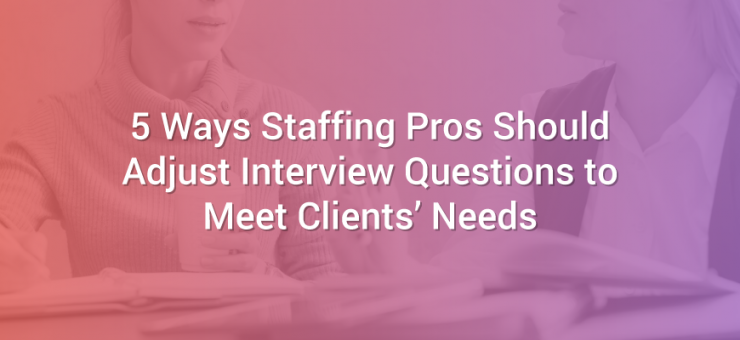A quick Google search gives job seekers all the ‘right’ answers to common interview questions during the hiring process. That’s why candidates often come in sounding similarly rehearsed during interviews. This also, unfortunately, reveals a trend of interviewers asking every candidate the same old questions.
In the current job market, your staffing process must be of high quality. We know there’s pressure to perform and meet the needs of clients. In fact, Bullhorn’s 2019 Global Recruitment Insights and Data research shows that people are the single biggest issue impacting an agency’s ability to achieve its future growth goals. Respondents overwhelmingly shared that finding quality candidates, working with the right clients, and hiring the right staff matters the most for their businesses to flourish.
Sure, consistency in the staffing process is vital to serve each client’s unique needs best. But effective hiring should mean strategically adjusting interview questions to better meet clients’ needs, as well as each role’s particular qualifications.
Rather than starting from scratch, here are some practical ways to change up interview questions as well as tips for how to identify the right change for each client:
1. Simply adjust the tone of the interview questions
Take a look at your standard set of interview questions. Decipher how you can change up the tone or phrasing of each question. This will ensure you can to better meet each client’s needs. Not only will this break away from the classic list of questions your candidate may expect, but it also sets you up to learn more about each interviewee.
For example, rather than asking a candidate to tell you about their greatest strengths, rephrase to ask them to share a career highlight or success that they’re most proud of. The original version of this question is likely one the candidate is expecting and has a list on cue to share, while the revised version of this question will require more thoughtful input and requires the candidate to showcase their strengths in motion.
2. Identify nuances in the work settings
Some roles will require an employee to adapt to a collaborative, open-office setting while others will involve remote work and a busy travel schedule. Work environments vary significantly from role-to-role. Identify the work setting for each role you’re seeking to fill for your clients. This will help you ask the right questions and better understand a candidate’s propensity for success in the role’s work environment.
For a role that requires more than 50 percent travel time, assess the candidate’s capacity for remote work. Use interview questions, whether situational or open-ended, to find out how well they can self-manage, their communication style, or their need for collaboration. Individuals that thrive in a work environment with a face-to-face team setting are not typically ones that flourish remotely.
3. Look to your clients’ mission statements
A company’s mission statement is just as crucial to their business as it is to its employees. Determine how your client’s mission manifests into ideal candidate traits for the role you’re staffing.
For instance, Lyft, a transportation network company you’re likely familiar with, has this mission statement: “Improve people’s lives with the world’s best transportation.” While short, there’s a lot you can pull from this. To work at this company, you have to be able to provide strong customer experience and have an interview in technology.
There are a few ways to go about utilizing a company’s mission. During the interview, you can incorporate the company’s mission statement into your interview questions to gauge cultural fit. This could be as simple as asking about a time when they went above and beyond for a customer. There’s also the option to ask what it means to provide an excellent customer-service experience.
4. Ask more on open-ended questions
The best way to gather information about a candidate and truly understand if they’re a fit for your client’s role is through open-ended questions. Being thoughtful about the creation of these questions will ensure the candidate will answer candidly. Open questions also leave space to follow up and the potential for more questions, which can make an interview even more beneficial for everyone involved.
For example, ask the candidate to tell you about a time they took a risk and failed. This is an improved form of a weakness question. If the candidate is on point, they will be honest and tell you about a time they failed, as well as how they worked to fix it or what they would do to handle the situation better if it happened again. Don’t forget to observe body language during these questions.
5. Focus on personal attributes for a cultural fit
Determine how important cultural fit is for your client’s role. Sometimes, hiring for personal attributes and a perfect fit into the company’s workplace is far more important than hard skills. Some clients require you to hone in on soft skills and personal attributes over the specific educational background or work experience.
Overhaul your interview questions to tap into your candidate’s soft skills to make sure they’re a match. For instance, if you’re hiring for a sales role, consider creating some role-playing scenarios to better understand how the candidate can handle the sales cycle with ease.
Can the candidate build rapport? How do these uncover the needs of the customer? Are they able to close? Tune into your client’s needs by adapting your interview questions every time.












